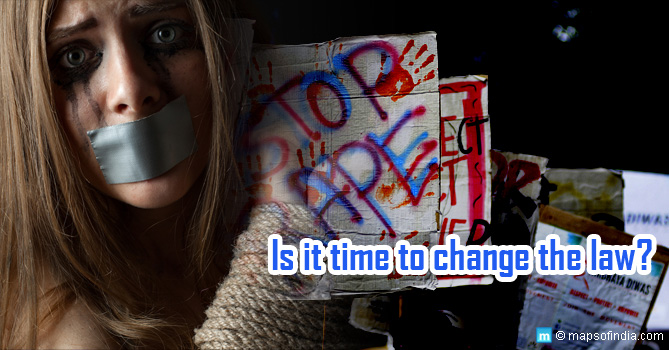Ironical. Disgusting. Outrageous. No matter what you feel or believe, the juvenile Nirbhaya rapist, who has turned 20 this year, became a free man when the Juvenile Justice Board signed his release order on 20 December 2015. Due to threat to his life, he was shifted out earlier from the Timarpur Juvenile Correctional Home and handed over to an NGO, under whose care and supervision his apparent rehabilitation is due to start.
To support the process, the government has expunged his criminal record, will hand him Rs 10,000 and a sewing machine, in the hope that he will be rehabilitated as a law abiding citizen and can join mainstream society.
The Delhi Commission for Women (DCW) chief Swati Maliwal, in a last minute appeal, approached the concerned Supreme Court Judge late Saturday night with a fervent hope that the Supreme Court would stay his release but the judge refused to oblige. The Supreme Court, however, will hear an appeal at 1030 hrs on Monday 21 December, but under current laws, there is almost no ground under which the apex court can overturn its own decision.
Parents of Nirbhaya have been doing their bit to stop the juvenile’s release and even tried to hold a protest at India Gate on Sunday evening, but were detained by the police and taken to Parliament Road Police Station. They will continue to protest at the Jantar Mantar on Monday.
This once again brings up the contentious debate between a victim’s right to seek justice and the society’s responsibility in giving a convict a second chance to reform. Civil society remains deeply divided on this issue.
How effective is the law in fulfilling its goal for either side?
Victim’s perspective
In the Nirbhaya case, she was a regular ordinary girl who had come to Delhi with dreams of educating herself and subsequently building a career. One day, on a cold winter evening, she stepped out with a friend and when returning, was forced to seek lift from a bus that agreed to give them a ride. The boy was badly beaten up and she was brutally gangraped. One of the rapists, the most brutal of them, turned out to be a juvenile at the time of committing the crime.
The Indian law states that a juvenile cannot be convicted as an adult, irrespective of the nature of the crime. And that is the genesis of the debate that has left civil society so deeply divided on this sensitive issue.
So, has the law been fair to Nirbhaya and her parents who want justice and seek closure for their departed daughter? All they now want is the juvenile be tried as an adult and suitably punished for his very adult crime? Shouldn’t the law give priority to the victim and ensure that justice be delivered?
As per current laws, it has been delivered. But has it? Does three years in a juvenile correctional home and subsequent release with Rs 10,000 and a sewing machine really give justice to Nirbhaya who was made to end her life and dreams in the most horrific way? What about closure for her parents who not only will have to contend with the loss of their only daughter, but live with the frustration of knowing that her rapist is living a free life out there? Clearly the current laws do not address this and needs to be reviewed.
Juvenile’s perspective
The law believes in giving a juvenile delinquent a second chance to reform and re-integrate into mainstream society, and therefore, they are kept in a correctional home and not in an adult jail. This may be an idealistic goal, but in reality, a correctional home in India is simply hell for a juvenile that offers no scope or chance to reform under the present system. In fact, it serves to further harden an already affected psyche.
Anyone visiting any juvenile correctional home in any state in India will be horrified to see the living conditions and prevailing situation among the inmates. These are places that follow a social hierarchy based on brute strength and any new entrant to the home is quickly forced to accept and conform to the prevailing social hierarchy. The process of accepting and conforming involves sodomy, brutal beatings, torture and humiliation, all with little or no interference from the authorities, who care little about what goes on in the inside. Pretty much on lines of how our prisons work.
In many cases, the authorities themselves turn perpetrators of all the above stated brutalities with the poor inmates having no one to turn to for protection. That is the ground reality of an Indian correctional home for juveniles. So to expect the Nirbhaya rapist to reform himself in a correctional home is being naïve and unrealistic.
A case to change the law
There is a lot of pressure on the government from civil society, intellectuals and general citizens, to change existing laws to lower the age at which a juvenile can be tried as an adult and to make punishment more stringent for crimes that are violent or heinous in nature.
So, will lowering the age deter juveniles from committing a crime? Has the law acted as a true deterrent in preventing someone from committing a crime, irrespective of age? After all, rape and even murder, is being committed by juveniles below the age of 14, so will lowering the age really help prevent heinous crime? Very likely not. Existing National Crime Records Bureau data does not show any reduction in serious juvenile crime.
Which brings us to the next question, is the juvenile correctional system in India really effective and working? Again the answer is no. No state can present scientific empirical data on how many juveniles were counselled and reformed and to what extent. In the absence of these, how does the government examine the merits and demerits of changing the law to make it both a deterrent and yet offer an opportunity to reform?
In the case of Nirbhaya’s rapist, can anyone holding authority claim that the time spent in a correctional home has made a positive impact on reforming this individual, who is now 20? And, can anyone in authority take responsibility to assure society that this individual will not commit another crime of similar nature? In the effort to reform this individual, can society risk the life of another potential victim?
The problem is that we do not have any system at all for scientifically monitoring an individual’s progress of integration with society at a physical and psychological level? Besides getting him to visit a police station on a regular basis, there is no system available in India that truly evaluates and records his progress and therefore, no one can state with any sense of authority that after releasing this man he shall not commit another crime.
So while it is time to revise our laws to take into account a changing society, it is also time to revisit the juvenile correctional system and to make it more scientific and humane. What do you think?





